Seaweed has got to be the most traditional and most futuristic food in the world, at the same time. It’s so interwoven into our culture and diet that we Japanese probably take it for granted, but as we sit here and wrap our onigiri (riceballs) in our nori (laver seaweed), there are real organizations out there that are researching seaweed as the answer to world hunger.
By the year 2050, the world population is projected to reach 9 billion. The big question is, how are we going to feed all those people without severely affecting our environment? Agriculture employs more than 28% of the world, whether it’s directly or indirectly, so we need agriculture for our global economic health. But agriculture also accounts for a major percentage of greenhouse gases, deforestation of our jungles and uses the majority of all the freshwater we take from our rivers and lakes. I don’t expect to be around in 2050, but my kids and their kids certainly will be; so this is serious business.
And being taken very seriously as a sustainable food source is the humble seaweed, familiar to many Asian countries for centuries. Today seaweed has been elevated to superfood status because of its nutritional benefits and the fact that it may save the world from starvation. And farming it requires no maintenance like weeding, fertilizing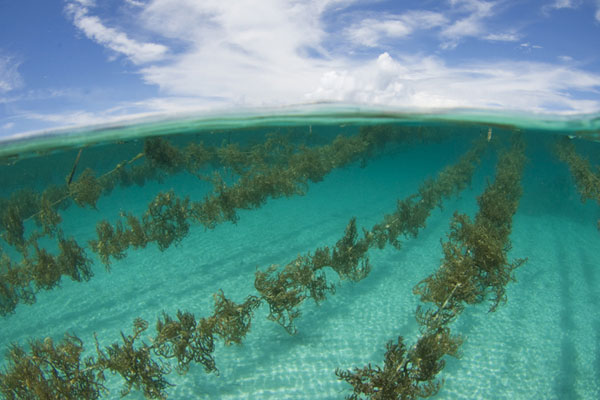 or watering; it leaves the environment cleaner by removing harmful excess nutrients from the water, and it doesn’t consume much in resources. Talk about the perfect crop!
or watering; it leaves the environment cleaner by removing harmful excess nutrients from the water, and it doesn’t consume much in resources. Talk about the perfect crop!
Seaweed farming began in Japan as early as 1670, so as an edible food, you might say the rest of the world is just catching up. The West has only just begun to realize its importance beyond being a wrapping for sushi. Don’t forget that seaweed is a potent source of umami as well, and world class chefs are well aware of how kombu is used to make soup stock.
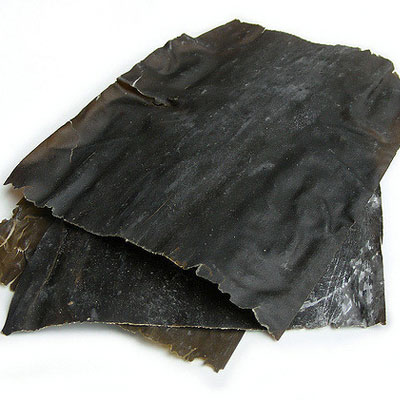 There are basically 6 types of commonly used seaweed varieties in Japanese cuisine.
There are basically 6 types of commonly used seaweed varieties in Japanese cuisine.
Kombu, which I just mentioned, is probably used everyday by homemakers in Japan. A kelp loaded with umami, kombu is an important ingredient in making dashi, or soup stock, especially for miso soup. The best kombu is gathered from the shallow waters off of Hokkaido; like most seaweed, it is high in calcium, iron and iodine, which the body needs.
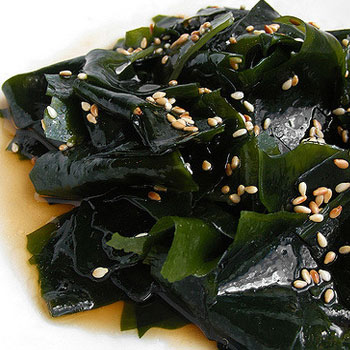 Wakame, which is more like a vegetable, is used in salads, in soups, marinated in vinegar, or simmered with other vegetables. Even though it’s bland and pretty much tasteless on its own, wakame becomes an excellent companion ingredient because of its semi-crunchy texture and its delightful, faint aroma of the sea. Wakame is probably the most popular type of seaweed in Japan.
Wakame, which is more like a vegetable, is used in salads, in soups, marinated in vinegar, or simmered with other vegetables. Even though it’s bland and pretty much tasteless on its own, wakame becomes an excellent companion ingredient because of its semi-crunchy texture and its delightful, faint aroma of the sea. Wakame is probably the most popular type of seaweed in Japan.
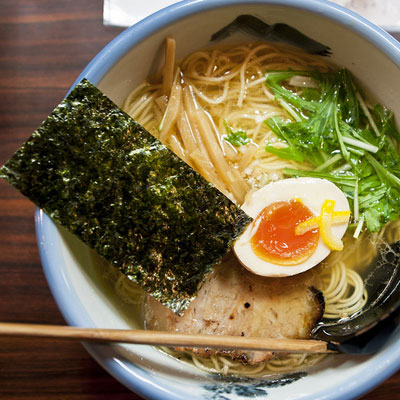 Nori, the seaweed that almost all Westerners know now as being edible and synonymous with sushi, is farmed and dried and cut into sheets like papermaking. You’ve also seen nori wrapped around riceballs, floating in bowls of ramen, and cut into little strips on top of cold soba (buckwheat) noodles. Some types are flavored with a little soy sauce and sweet mirin (rice wine), called Ajitsuke Nori, and can be eaten alone with plain white rice. You’ll see this in a classic Japanese breakfast sometimes.
Nori, the seaweed that almost all Westerners know now as being edible and synonymous with sushi, is farmed and dried and cut into sheets like papermaking. You’ve also seen nori wrapped around riceballs, floating in bowls of ramen, and cut into little strips on top of cold soba (buckwheat) noodles. Some types are flavored with a little soy sauce and sweet mirin (rice wine), called Ajitsuke Nori, and can be eaten alone with plain white rice. You’ll see this in a classic Japanese breakfast sometimes.
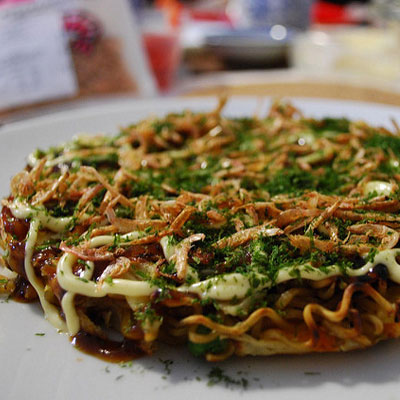 Aonori is another kind that you may not have noticed, used to sprinkle over yakisoba (pan-fried noodles) or okonomiyaki (savory pancakes). This green, fine-flaked nori gives these dishes an added seasoning and makes an attractive presentation.
Aonori is another kind that you may not have noticed, used to sprinkle over yakisoba (pan-fried noodles) or okonomiyaki (savory pancakes). This green, fine-flaked nori gives these dishes an added seasoning and makes an attractive presentation.
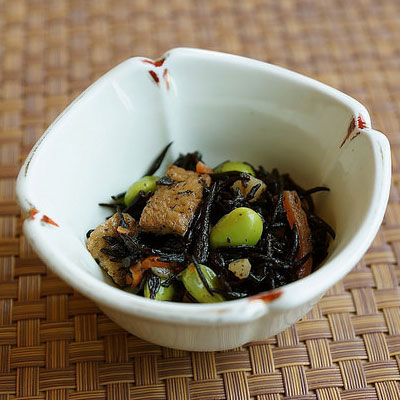 Hijiki, a dark, almost blackish sea vegetable that can be found dried in stores, has been a part of the Japanese diet for centuries. Its nutritional properties and the macrobiotic movement of the seventies made it popular and more readily available in the West, where hijiki is now recognized for its culinary uses. In Japanese cuisine, hijiki can be found as a seasoned side dish, as flavoring in mixed rice, or as an added ingredient in stir frys and simmered vegetables.
Hijiki, a dark, almost blackish sea vegetable that can be found dried in stores, has been a part of the Japanese diet for centuries. Its nutritional properties and the macrobiotic movement of the seventies made it popular and more readily available in the West, where hijiki is now recognized for its culinary uses. In Japanese cuisine, hijiki can be found as a seasoned side dish, as flavoring in mixed rice, or as an added ingredient in stir frys and simmered vegetables.
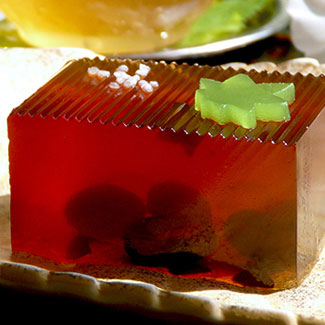 Kanten, also known as agar-agar, is a popular diet food because it contains no calories, yet its fiber content helps the body as an intestinal regulator–it’s been taken seriously in obesity studies. Basically a vegetable gelatin with no flavor on its own, kanten is popular in Japan for its versatility and used in sweet desserts like puddings, custards and cakes, or eaten like Jello.
Kanten, also known as agar-agar, is a popular diet food because it contains no calories, yet its fiber content helps the body as an intestinal regulator–it’s been taken seriously in obesity studies. Basically a vegetable gelatin with no flavor on its own, kanten is popular in Japan for its versatility and used in sweet desserts like puddings, custards and cakes, or eaten like Jello.
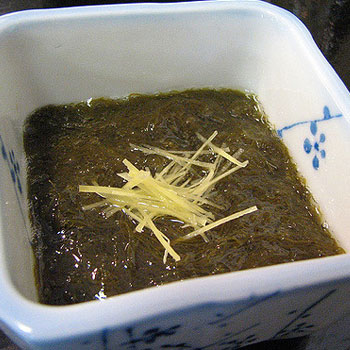 Mozuku, produced mainly in Okinawa and popular all over Japan, may be the most foreign to Westerners. It has a stringy, slimy quality that might need some getting used to, but the refreshing taste, especially when marinated with a sweet vinegar, can be habit forming. You might say it most resembles a seaweed that you fished right out of the ocean, but it is surprisingly mild and not as briny as you might think. Take a leap of faith and try this one.
Mozuku, produced mainly in Okinawa and popular all over Japan, may be the most foreign to Westerners. It has a stringy, slimy quality that might need some getting used to, but the refreshing taste, especially when marinated with a sweet vinegar, can be habit forming. You might say it most resembles a seaweed that you fished right out of the ocean, but it is surprisingly mild and not as briny as you might think. Take a leap of faith and try this one.
So if seaweed has the potential to save mankind from future starvation, why hasn’t it advanced beyond “ethnic food” status? Like any kind of food you haven’t grown up with, it takes time to acquire the taste. But researchers and chefs are working together these days, who really believe in the future of seaweed. After all, we’re eating vegetables that grow in dirt aren’t we? Seaweed just happens to grow in the oceans.
Credits: World Resources Report
Seaweed Farm by Adam Broadbent for Scubazoo
Seaweed salad by Steven Depolo
Kombu & Wakame by Robin
Ramen nori by Michael T.
Aonori by Alpha
Hijiki by TokyoViews
Kanten dessert by Alex
Mozuku by Pablo

Leave a Reply